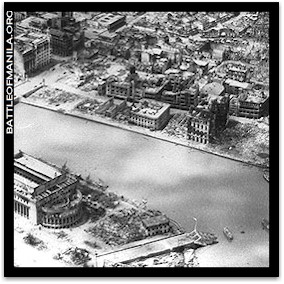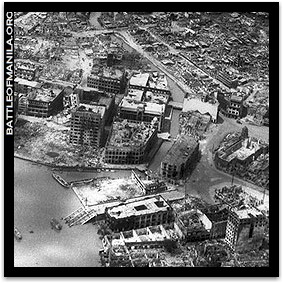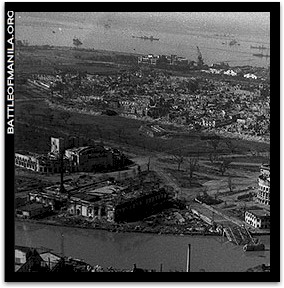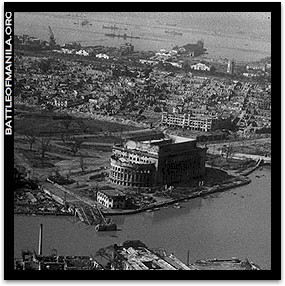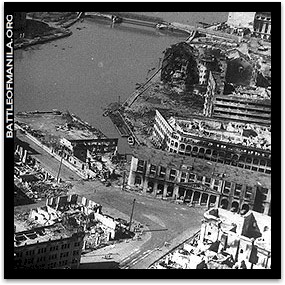|
d. Demolitions:
Demolitions played an important part in the defense of the city, inasmuch
as they were used to great effect in destroying bridges prior to our entry
and in demolishing sections of buildings after occupation.
Evidence of prior planning of bridge demolition is contained in the
following extract:
"Manila Defense Op Order A No. 1. (Shimbu Gp)
Santa
Mesa
Defense Force Order
2300, 3
Jan 45
"6. Manila Detachment will firmly occupy the key
points in the city. Thus it will endeavor to annihilate the enemy airborne
forces and thus decrease his fighting strength, and simultaneously the
Detachment will take charge of preparations for protection and destruction
of Main installations, especially bridges, in the city.
"At key points of traffic, particularly at
bridges, the Detachment will check the north and south movements of enemy
armored cars. The area of the line connecting west of Novaliches
(included), Meycauayan and the lower reaches of the Meycauayan River at
Meycauayan, and that north of small stream to north of Manila will be
newly added to the combat area of Manila Detachment.
"8. South Flank Detachment Commander will be
responsible for the protection and destruction of Pasig Bridges with a
portion of one Infantry Company which has been dispatched to the vicinity
of Sakura Barracks and with the forces mentioned in the foregoing
paragraph."
Of a total of about 101 bridges in the city of
Manila and immediate environs, thirty-nine, were destroyed. The most vital
bridges, as far as the tactical situation was concerned, were the six
bridges over the Pasig River joining the northern and southern sections of
the city. All of these were destroyed. In the section north of the Pasig
River, there was a total of fifty-eight bridges, of which nineteen were
destroyed.
In the section south of the Pasig River there were
thirty-seven bridges; twenty destroyed. The greater percentage of
destroyed bridges south of the Pasig River may be explained by the fact
that the enemy withdrew toward the south and consequently had more time
for demolition work in this section.
As a general rule, the bridges destroyed were from
one hundred to four hundred feet long, while those left intact were much
shorter and never exceeded seventy feet in length.
Except for certain bridges over the Pasig River,
all bridges in the city were blown prior to the entry of our troops. Those
over the Pasig were destroyed about the time our troops reached the north
bank of the river. The precise time of demolition of those destroyed prior
to our entry is not known, but it was probably 3 February, as implied by
the following captured order:
Manila Naval Defense Force Op Order No. 44
3 Feb 45
Manila Naval Defense Force Comdr Iwabuchi, Mitsuji
"1. The North and South Forces will immediately
destroy all bridges in the suburbs with the exception of Novaliches
Bridge, (The Kobayashi Gp (Heidan) will be responsible for the Marikina
and Pasig Bridges) 33 (MA) (San Juan) Bridge and the five large' bridges
(1 (1),2 (RO), 3 (HA), 4 (NI), 5 (HO) ) over the Pasig River.
As to the demolition of the above mentioned
bridges and of various small bridges in the vicinity of the principal zone
of city, special orders will be given. However, the time of demolition
will be about the same time as that for the demolition of the 4 large
bridges.
"2. The demolition must be done completely and
thoroughly. In order to prevent the guerrillas from action to construct
bridges, and to prevent speedy transmission of intelligence and passage
across, several guard personnel will be posted at the completely
demolished principal bridges.
"3. Each unit will quickly report as soon as
the principal bridges are destroyed.”
Practically every important bridge in the city was
destroyed. The relatively few left intact represented very difficult
demolition jobs, a fact which suggests that the enemy lacked sufficient
qualified personnel to undertake them. As a whole, the bridge demolition
work was better executed and destruction more nearly complete in the
Manila area than in the Central Plains of Luzon. Most of the bridge
demolition.in Manila would be considered good by American standards.
Japanese bridge demolition was marked by the
following general characteristcs:
(1) On multiple span bridges, the span on the
Japanese side was usually blown. Other spans in many cases were prepared
for demolition but often remained intact.
(2) In the demolition of concrete slab bridges,
the enemy apparently concentrated on the destruction of the bridge
decking.
(3) Concrete arch type bridges were found blown in
middle sections.
(4) Steel truss bridges were sheared close to the
supports with only abutments and piers left standing.
(5) No bridges of any type were found that had
been prepared for time demolition after our entry.
The only other significant use of demolitions
was encountered during the assault on fortified buildings.
In
many instances our entrance and subsequent occupation of a small section
of a structure were met by controlled blasts affecting only that portion
held by our forces. Usually charges were too light to cause the
destruction intended by the enemy. By this means, however, obstacles were
often created, and re-entry by another route made necessary.
V. WEAPONS AND THEIR EMPLOYMENT
1.
General
The relatively small enemy garrison left for the
defense of Manila proper had a great variety of weapons and ammunition.
Months of preparation made possible systematic adaptation and
improvisation of weapons for ground defense. One captured order, dated 18
December 1944, stated that "the time of decisive battle on Luzon Island is
drawing nearer and nearer", and ordered the rapid execution of combat
plans. Guerrilla reports of that period referred to accelerated defense
preparations, the construction of underground machine shops, the
installation of demolitions in buildings, and the salvaging of war
materials in Manila. A captured undated memorandum, presumably of the
Manila Naval Defense Force, called for the immediate manufacture of
two-wheeled carriages for 25mm and 13mm machine guns, "the wheels to be
found regardless of the circumstances". Another document directed that as
large a quantity of aviation gasoline and bombs as possible be removed
from the suburbs to suitable places within the city so that they might be
used as "weapons of attack or as material for the production of weapons".
Scrap metal was saved, captured U. S. weapons and ammunition were made
ready, and guns were moved from sunken ships and wrecked aircraft.
Ordnance shops were found in Manila, several located in underground
tunnels. In these the enemy had produced ground mounts for aircraft
machine guns, hollow charge lunge mines, grenades, demolitions and
improvised mines. The result was to give the defense force a concentration
of automatic and support weapons out of proportion to its numerical
strength.
Time also permitted some care in the selection and
preparation of sites for all kinds of weapons. Slots for rifles and
machine guns often at knee height were made in the walls of buildings.
Although this arrangement restricted traverse, the apertures afforded
excellent cover of shrewdly selected fields of fire. In the Laloma
Cemetery, three 25mm automatic cannon, hidden in pillboxes camouflaged as
burial mounds, complete with sod, flowers and statues or crosses, were
emplaced for use solely against strategic traffic focal points. In one
confirmed instance an artillery piece was emplaced on an upper floor of a
downtown building, and many antiaircraft guns fired into the streets from
barricaded rooms in upper stories.
While within each center of resistance the fire plans apparently were
charaderistical1y thorough, coordination was lacking in the firing of
weapons during the defense. This was probably attributable in large part
to poor communications and weak overall organization of the miscellaneous
units of the command. Control of the fire of individual weapons was
reported as good, with last-minute ambush fire at point blank range
repeatedly used to good
·effect by enemy riflemen,
machine gunners and anti-tank gunners. The detonation of electrically
controlled mines in buildings was also delayed until the critical moment.
Each weapon was generally so emplaced and protected that, even after
adjacent positions had been overrun, it remained capable of sustained fire
on its original target area until individually rooted out or destroyed.
Except for miscellaneous army units north of the
Pasig River, Japanese naval personnel were charged with the defense of
Manila. In consequence, relatively few army infantry weapons were used.
Some 75mm field guns, a few 47 mm anti-tank guns, standard infantry
machine guns, 81mm and 90mm mortars, and 50mm grenade dischargers were
encountered. In addition, Army 20cm spin-stabilized rockets with Type 4
launchers were employed in negligible quantity.
A prisoner of war confirmed the removal of 12cm
naval guns and anti-aircraft guns from partially submerged ships in Manila
Bay to positions within the city. Aircraft 20mm cannons and anti-aircraft
25mm guns were mounted and emplaced for ground use. On occasion, U. S.
Enfield and M1903 rifles, M1911 pistols, Browning automatic . rifles,
heavy machine guns and cal .50 machine guns were encountered, and a
prisoner verified their use. A few captured M-1 rifles were found on enemy
dead.
Most of the weapons encountered in Manila and
referred to in the following discussion are described and illustrated in
current manuals and bulletins on Japanese weapons. Some of the newer types
are illustrated in the Annexes. (Part Three).
2.
Grenades
Hand
grenades were used extensively during the street and room-to-room fighting
in Manila. Type 91 and type 97 hand grenades, stick grenades and conical
hollow-charge "grass skirt" hand grenades (see
Annex 36) were commonly
employed. Grenades were found near almost every Japanese position.
Molotov cocktails, many with red phosphorus as the
incendiary substance, were found in practically every house and building
that had been occupied by the enemy. It is believed that they were used to
start the many fires the Japanese left in the areas they evacuated. These
incendiaries were also dropped into the streets from windows of buildings
and thrown from room to room and floor to floor. They produced relatively
few casualties but were effective delaying weapons.
Small (1-3 kg) aerial bombs intended for use
against parked aircraft were dropped from the upper stories of buildings
on our troops below and proved effective as hand grenades. Some were found
on the ground with dented noses, indicating that the arming vane had
failed to rotate sufficiently to arm the bombs and permit detonation. -.
Small cakes of explosives were found with a pull
type igniter, a short piece of delay fuse, and two or three blasting caps.
They served as hand grenades and as booby traps. Another improvised
grenade consisted of a 2¾" length of 2" pipe, a blasting cap, a cal. .22
shell (captured U. S.), fuse, and powder. The ends were plugged with soft
scrap metal.
3.
Small Arms
The enemy in Manila made conventional use of
rifles and automatic weapons. Despite frequent mention by our troops of
"snipers," the sniper as a carefully placed individual rifleman
specializing in long-range selective firing seldom made an appearance
(hardly any telescopic rifle sights were found in Manila). Standard
Japanese infantry rifles were not encountered in large numbers, and
quantities of captured U. S. rifles were recovered by our forces still
packed and unused. Because of the high proportion of automatic weapons,
the rifle became a secondary weapon for harassing fire, protection of gun
positions, and personal defense.
4.
Automatic aircraft and anti-aircraft weapons
Aside from the adaptation of aircraft and
anti-aircraft weapons to ground use and the high proportion of automatic
fire thus achieved, there was little out of the ordinary in the employment
of automatic weapons in Manila. Fire of weapons in adjacent positions was
apparently not closely coordinated for surprise or massed effect, although
a formidable volume was often achieved.
The 25mm automatic cannon Model 96, apparently the
basic automatic anti-aircraft weapon of Japanese naval units, was used in
great number in Manila. The majority encountered were of the fixed single
mount variety. These weapons, capable of delivering an estimated 250
rounds per minute, fired HE, HE tracer, and AP ammunition. They were used
throughout the city, a few being emplaced for employment in a dual role
and many for ground fire only.
Twenty mm aircraft machine cannon Model 99, both
fixed and flexible, were frequently converted to ground weapons. They were
undoubtedly removed from some of the many Japanese aircraft destroyed on
the ground by our air strikes. Their great volume of fire was effective in
delaying our forces. The muzzle blast of both the 20mm and the 25mm guns
made them easy to locate, however. At least two 40mm anti-aircraft guns
were also used against our troops in Manila.
The other principal automatic weapons were the
13mm machine gun Model 93, the 7.7mm Lewis machine gun Model 92, and the
7.92mm light Bren-type machine gun. Conventional Japanese army infantry
machine guns were encountered in fewer numbers.
5.
Mortars
Mortars were used extensively for harassing fire,
occasionally in conjunction with artillery fire. They were more effective
than artillery in producing casualties and delaying our forward elements.
Emplaced behind buildings, the mortars were difficult to locate. The
calibers most commonly encountered were 15cm, 90mm and 81mm. (Although a
new type of 81mm anti-aircraft mortar ammunition functioning as a
parachute bomb was found in Manila in 10 February, no reports were
received of its use).
On some occasions 50 mm grenade dischargers were
used by the enemy inside buildings for direct fire, and throughout the
city they were effectively employed against our troops in streets and
buildings.
6.
Artillery
In Manila, as elsewhere in the Pacific, the enemy
used his artillery as if for psychological effect rather than for
devastation. He seemed to choose as preferred targets our battalion,
regiment and division command posts, and placed accurate fire on them.
Other targets notably singled out were the areas of activity at the Allied
internee concentrations in Old Bilibid Prison and Santo Tomas University.
In addition, much harassing fire was delivered on our forward elements.
Occasionally a critical target such as a tank park was selected. In Manila
the enemy appears to have been too preoccupied with immediate targets to
attempt counterbattery fire. Pre-registered fires were frequently employed
to cover minefields, critical road junctions, and buildings most likely to
be used by our advancing forces.
On targets of all kinds, the enemy failed to mass
his fires for destructive effect. Except during a few periods at the
height of the battle for Manila, he directed the fire of only one to three
guns at a given target. In this way he drew our counterbattery fire on a
minimum of targets and conserved some of his pieces for later use.
The main artillery weapons used in the defense of the city were the
12cm Type 10 high angle gun (navy) ; the
8cm (3 inch), 10-year type high angle gun (navy) ; and the 75mm field
gun Model 38 on either a
wheeled carriage or a modified pedestal mount.
The 12cm high angle naval gun formed the backbone
of the Japanese artillery defense. Thirteen were captured or found
destroyed in firing position in Manila, and others located at Nichols
Field and Fort McKinley were actively employed. They were set on pedestal
mounts, permitting wide traverse. A few were emplaced for both
antiaircraft and ground fire. In the Laloma Cemetery a two-gun battery (a
third gun was on hand but not emplaced in its intended position) was sited
with an open view for AA fire and had wide horizontal views for
interdicting two main approaches to the city.
To compensate for the lack of natural concealment,
camouflage netting was used to mask each emplacement. These two guns also
covered a minefield lying south of Grace Park airfield. Near the Manila
Water Department reservoir two other 12cm guns were located; one of them
destroyed two of our medium tanks.
Time-fused incendiary shells were used to start
many of the city fires which destroyed blocks of buildings in the
immediate path of our advance. Air bursts about twenty feet above the
roofs discharged incendiary pellets into the buildings, while accompanying
high explosive air bursts discouraged immediate fire-extinguishing
operations. A normal proportion was two or three high explosive shells to
one incendiary.
Direct fire, principally of 47mm and 75mm guns,
was used from time to time both in street fighting and against buildings.
During the shelling of Santo Tomas University, direct fire against
buildings came from a 75mm gun or guns situated in an upper floor of an
enemy-held building. Authentication of such an emplacement is found in the
following translation of excerpts from a captured message book which
belonged to a Probationary Officer BATA (unit not stated):
10 Feb—At 3d Shipping Hq.
"0130—2d Lt AINOUCHI came from Detachment
Headquarters and requested me to emplace one field gun; we decided to put
the OP on top of the building and emplace the gun on the third floor.
0500—2d Lt AINOUCHI and artillery personnel came
from Detachment Headquarters and by using Chinese coolies carried the gun
up to the second floor. Later, the platoon leader and 6 men came to help
and, with their cooperation, we carried the gun up to the NE corner of the
third floor.
0830—Commenced firing. Target—Santo Tomas
University. Distance—3400 (TN: possibly meters). First round burst 5 mils
to the left of the building. Aimed to the right and fired two rounds. They
hit to the right and at the base of the building. White smoke is seen.
Thereafter we fired fifty to sixty rounds continuously; fell in the
vicinity of the target.
1000—Until 1000 the enemy did not fire. An enemy
plane is flying over and appears that it is making an observation of our
positions. About this time one enemy shell landed on the center of this
tower, and shrapnel fell. Approximately one minute thereafter two more
rounds landed. Our forces continued their fire.
Ten minutes after the first round, four rounds in
succession fell. Four more rounds followed and hit the pillar. One of
these fell in the vicinity of our position. Before the first enemy round
landed, I encouraged the gunners, asked them to oil the muzzle of the gun,
and went down to my quarters."
/4
|





